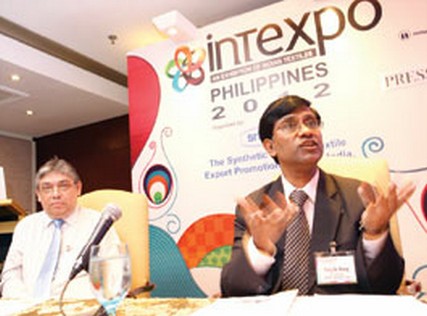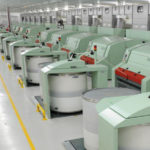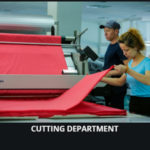In order to explore new markets and as part of its promotional programme, the Synthetic & Rayon Textiles Export Promotion Council (SRTEPC) held for the first time an exclusive Indian Textile Exhibition in Manila, Philippines from 23rd to 24th May 2012.
Sixteen Indian textile companies showcased their latest range of fabrics and yarns at the Intexpo Philippines 2012, an Indian textile exhibition and buyers-sellers meet, at the Dusit Thani Hotel Ballroom B, Makati City.Organized by the Synthetic & Rayon Textiles Export Promotion Council (SRTEPC) of India, in association with the Embassy of India, Manila, and in cooperation with the Philippine Chamber of Commerce and Industry (PCCI) and the Philippine India Business Council (PIBC), participating textile companies included Balavigna Weaving Mills (P) Ltd., Best Textiles Limited, BSL Ltd., Gini weaving Industries Pvt. Ltd., Madhusudan Rayons Pvt. Ltd., Mahajan Textile Finishers Pvt. Ltd., P.D. Impex, Raveesh Overseas, Shomer Exports, Shree Mahadeo Cotton Mills Ltd., Soflene Textiles Pvt. Ltd., Topman International Ltd., Trinity Worldwide, Tulip Exim, Virgo Suitings Pvt. Ltd. and Enigma Ventures Pvt. Ltd.

Philippine-India Business Council chairman Johnny Chotrani and Srijib Roy of the Synthetic & Rayon Textile Export Promotion Council.
The exhibition aims to strengthen existing trade relations between the two countries and initiate awareness on Indian textile industry and its products. The exhibit offers an opportunity for the Filipino garment maker and textile importers to explore the possibility of discussing profitable business deals and interact closely with their Indian counterparts.
“During the exhibition, senior representatives of the 16 Indian companies, which manufacture and export a wide range of synthetic and blended textiles including yarn, fabrics and made-up items, will spend two days in Manila, meeting the business community of the Philippines, establishing personal contacts, interacting closely for exploring avenues for joint ventures and negotiating mutually beneficial business deals,” says SRTEPC chairman Vinod Kumar Ladia.
Trade data from the Department of Trade and Industry shows that bilateral economic relations between the Philippines and India for the period January to October 2011 have increased by 12.25 percent. In fact, during the last three years, the Philippine export of Indian synthetic fabrics and yarns increased substantially from US$ 5 million to US$ 13 million.
“From 2006 to 2007, the Philippines had exported US$ 9 million worth of Indian textile. But in 2008 to 2009, the figures dropped to US$ 5 million because of the economic crisis. Then, export data climbed again and kept growing stronger: in 2009 to 2010, export amounted to US$ 10 million, and increased to US$ 13 million in 2010 to 2011. Exports of Indian textiles to the Philippines have increased by 160 percent during the last three years,” shares SRTEPC’s Srijib Roy.
He adds that US$8.13 million of the US$ 13 million, the biggest bulk of the import, was spent on yarns; followed by fiber (US$3.19 million), then fabrics and made-up, both amounted to US$ 1 million each.
“The figures can be translated that the Philippines creative industry, particularly weaving, is outsourcing their raw materials. You have a very vibrant creative industry. You can create good quality textile products and market them abroad. But your limitation is the raw materials. The Philippines needs raw materials and fabrics, but it doesn’t produce them,” says Roy.
Today, India is the largest producer and importer of man-made fiber in the world, and second largest producer of rayon fiber. Indian synthetic and rayon textile worth nearly US$ 4645 million – a big jump from US$ 2618 in 2007 – are exported annually to 168 countries. The Middle East and the Gulf have the largest block of Indian exports, about 25 percent; followed by Asia, 23 percent, then European Union, 22, North and South America, 19, Africa, 10, and others, one percent.
The leading markets for Indian synthetic textiles are the United Arab Emirates, Pakistan, Turkey, Afghanistan, USA, Brazil, United Kingdom, Bangladesh, Saudi Arabia and Germany.
“The secret to India’s success lies in the unmistakable quality of its textile, competitive prices and reliable supply,” concludes Roy.





